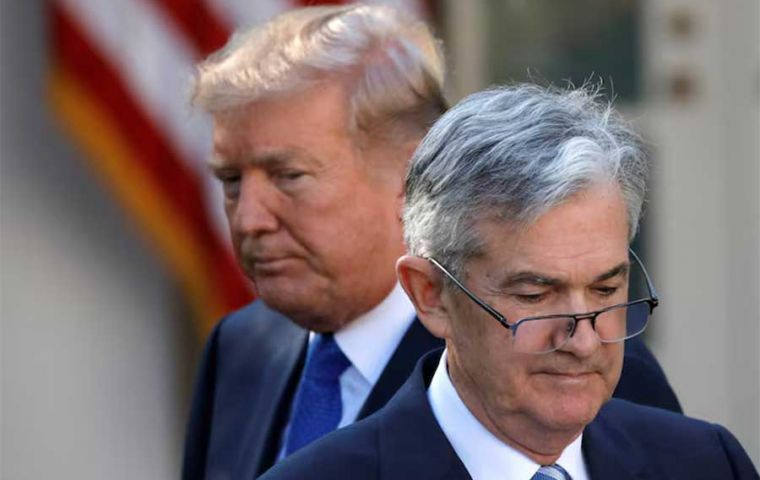MercoPress. South Atlantic News Agency
US Federal Reserve cuts rate by 25 basis points, but future decisions to be conditioned by Trump and Republicans dominance
 Powell whose mandate ends in May 2026, said if Trump were to ask him to leave, he wouldn't go, and that such a move isn't permitted by law.
Powell whose mandate ends in May 2026, said if Trump were to ask him to leave, he wouldn't go, and that such a move isn't permitted by law. The US Federal Reserve’s Open Market Committee cut interest rates by a quarter percentage point, on Thursday, the same week in which Donald Trump was swept in as elected president with a Legislative and Judicial branch packed with his conservative populists.
The FOMC voted unanimously on Thursday to cut its benchmark rate by 25 basis points to a new range of 4.5%-4.75%. The decision was made at the conclusion of its two-day policy meeting in Washington, D.C.
The move marks the second rate cut in seven weeks, following a jumbo half percentage point reduction in September that kicked off the Fed’s first easing cycle in more than four years.
This new cut was justified, according to the FOMC as a way of supporting its dual mandate to maintain stable prices and maximize employment. But contrary to its September statement the Federal Reserve removed language saying it had “gained greater confidence” that inflation was moving towards the 2% target.
Fed Chair Jerome Powell told the media on Thursday that those language changes were not designed to communicate that the Fed could pause its rate-cutting cycle in December or was newly concerned about inflation.
Instead the Fed decided to remove “gained further confidence” because that confidence had been gained ahead of the Fed’s first cut in September.
He also declined to say what the Fed might do in December at its last meeting of the year and also made it clear that the Fed’s path down to a more neutral rate stance has not changed since the first cut in September.
“We will just have to see where the data leads us,” he said.
However it is also true Fed policymakers had to detangle a lot of mixed data indicating both persistent (services) inflation and a jobs market disrupted by weather conditions and worker strikes.
The latest reading from the central bank’s preferred inflation gauge, the Personal Consumption Expenditures (PCE) index, contained both good news and not-so-good news for the Fed as it works to get inflation down to its 2% goal. It showed inflation rose 2.1% during the month of September, a thin distance from the Fed’s target.
But the complicating factor was that on a “core” basis, which excludes volatile food and energy prices, PCE was 2.7% — holding at the same level as August. And that’s the Fed’s preferred way to look at the measure.
Another issue for policymakers to consider was that core PCE has now held at 2.7% for three straight months instead of dropping.
An additional complication was that the health of the job market was clouded by the latest Labor Department report that showed only 12,000 jobs were created during October. That low figure was due in part to the temporary effects of two hurricanes and a strike at jet maker Boeing.
At his press conference, Fed Chair Powell faced some questions about Trump’s victory this week and what it could mean for his tenure as chair as well as the future of central bank policymaking. He said if Trump were to ask him to leave, he wouldn't go, and that such a move isn't permitted by law.
Reporters also asked about Trump’s promises of broad tariffs and immigration deportations as well as what those actions could do to the economy, the deficit, and inflation — and thus the path for monetary policy going forward.
But Powell declined to discuss what the potential policies of the next administration might do to economic conditions, except to say the Fed would evaluate those policies when and if they became law.
It is not yet known what the election result means for Powell in the long run. Powell's term atop the central bank ends in May 2026, and Trump will be able to choose the next face of US monetary policy. Trump first appointed Powell to his seat in 2018.
On the campaign trail, Trump talked he wanted a say in setting interest rates but then immediately walked that comment back




Top Comments
Disclaimer & comment rulesCommenting for this story is now closed.
If you have a Facebook account, become a fan and comment on our Facebook Page!